Consumer Price Index in NCR grows by 0.8 percentage point from its previous month's level
This April 2022, the CPI in NCR stands at 110.3, up by 0.8 percentage point from 109.5 percent in March 2022. On yearly basis, the CPI grew by 4.6 percentage points in April 2022 from 105.7 in April 2021. The CPI in NCR consistently remained below the Philippine’s record of 113.4. Across all regions, the CPI in NCR was still the second-lowest among the 17 regions with Central Visayas garnering the least at 110.0. On the other hand, Bicol Region registered the highest CPI with 117.6.
The CPI of 110.3 in April 2022 indicated that consumer prices, on average, have increased by 10.3 percent from the base year 2018. lt can also be interpreted that a basket of commodities that can be purchased at PhP100.00 by an average Filipino household in NCR in 2018 can be bought at PhP110.3 in April 2022. (Figure 1).
Figure 1. Consumer Price Index, All Items: NCR
April 2021 - April 2022
(2018=100)
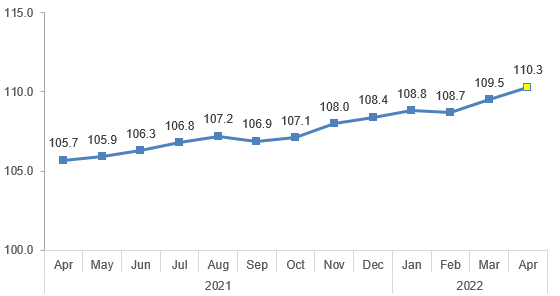
Inflation rate in NCR increases further to 4.4 percent
The inflation rate in NCR increased further to 4.4 percent in April 2022, from 3.4 percent in March 2022. This was the second-highest inflation recorded since January 2019 with 4.6 percent. Meanwhile, the inflation rate in April 2021 was lower at 2.4 percent. The average inflation rate for the first four months of the year stood at 2.8 percent. (Figure 2)
Figure 2. Inflation Rates in NCR, All Items
April 2021 - April 2022
(2018=100)
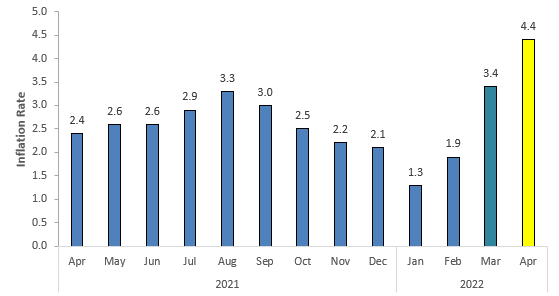
Across all regions, the inflation rates in NCR together with CARAGA region were in 5th place with lower inflation rate in April 2022. The lowest inflation rate was observed in Bangsamoro Autonomous Region in Muslim Mindanao (BARMM) with 2.1 percent while Cordillera Administrative Region (CAR) registered the highest with 6.3 percent. Headline inflation in the Philippines was observed at 4.9 percent. (Figure 3)
Figure 3. Year-on-Year Inflation Rates by Region, All Items
April 2021 - April 2022
(2018=100)
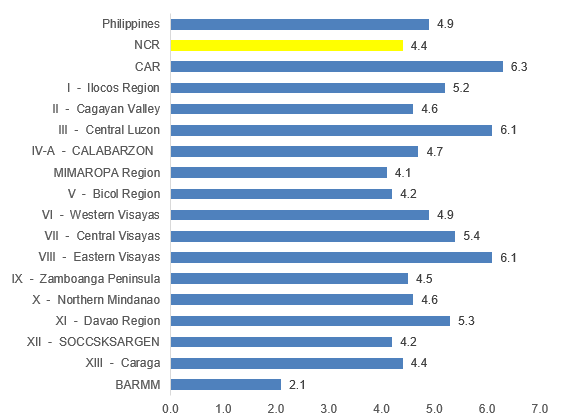
Food and non-alcoholic beverages contributes largely to the faster inflation in NCR
The increase in the region’s inflation was largely brought about by the higher inflation of food and non-alcoholic beverages at 3.4 percent, from 1.5 percent in March 2022. The higher inflation was also influenced by higher inflation in housing, water, electricity, gas and other fuels with 6.0 percent, and transport with 12.3 percent. In addition, what contributed to the uptrend in the overall inflation during the period were faster annual increments in the indices of the following commodity groups as compared with their previous month’s inflation rates:
a. Alcoholic beverages and tobacco, 5.2 percent;
b. Furnishings, household equipment and routine household maintenance,
3.1 percent; and
c. Health, 1.6 percent
Meanwhile, annual upticks slowed down in the indices of clothing and footwear (0.8%); recreation, sport and culture (0.7%), and restaurants and accommodation services (2.5%). The rest of the commodity groups either retained their previous month’s inflation rates or had zero percent annual growth. (Tables 1)
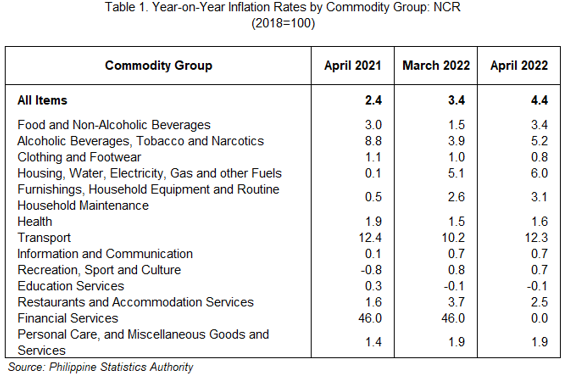
The annual growth rate in the food index increased further to 3.6 percent in April 2022, from 1.5 percent in the previous month. In April 2021, the food index had 3.3 percent inflation.
The inflation rate of vegetables, tubers, plantains, cooking bananas and pulses went up to 14.2 percent during the month from 2.6 percent in the previous month. In addition, a double-digit growth rate was observed in oils and fats index at 10.3 percent.
The following food commodity groups also exhibited higher annual increments in April 2022 as compared to March 2022:
a. Flour, bread and other bakery products, pasta products, and other cereals,
5.4 percent;
b. Meat and other parts of slaughtered land animals, 3.6 percent;
c. Fish and other seafood, 6.5 percent;
d. Milk, other dairy products, and eggs, 1.9 percent;
e. Sugar, confectionery and desserts, 5.4 percent; and
f Ready-made food and other food products n.e.c., 3.2 percent.
On the other hand, the inflation of corn moved at a slower rate of 10.7 percent in April 2022 from 13.3 percent in March 2022. Similarly, the fruits and nuts index eased down with -12.1 percent inflation during the month from -11.7 percent in March 2022. Meanwhile, the rice index remained at -0.2 percent inflation. (Table 2)
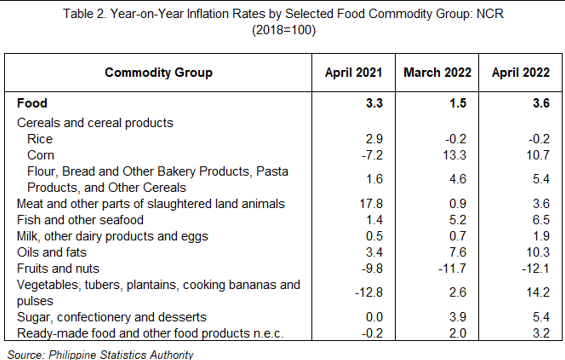
Purchasing Power of the Peso (PPP) remains at 0.91
The PPP is a measure of the real value of the peso in a given period relative to a chosen reference and is computed by getting the reciprocal of the CPI and multiplying the result by 100. The PPP is inversely related to the CPI thus an increase in the CPI will result in a decrease in the PPP.
In April 2022, the PPP in NCR remained at its previous month’s level of 0.91. The increase in CPI between the period March and April 2022 did not significantly affect the PPP in NCR. Meanwhile, the PPP in April 2021 was at 0.95. (Figure 3)
Figure 3. Purchasing Power of the Peso: NCR
April 2021 - April 2022
(2018=100)
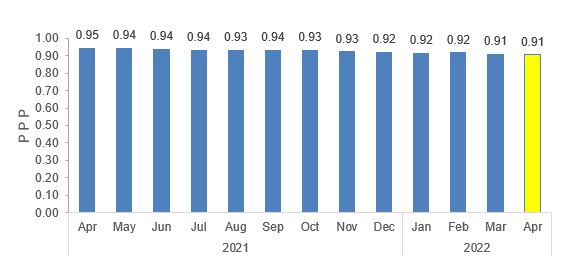
(Sgd.) PACIANO B. DIZON
Regional Director
